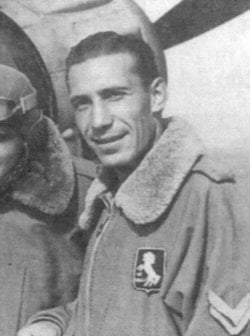By Robin J. Brooks
On the 15th August 1945 the diarist of No.500 (County of Kent) Auxiliary Squadron recorded: “The World War is ended. The Japanese formally surrendered this morning. Today and tomorrow have been declared holidays except for those on certain work.” This was followed by a visit by the Air Force Commanding Desert Air Force, Air Vice-Marshal Whitford who told the squadron that it was to be posted to Eastleigh in Kenya form their present base at Villa Orba. It would also be re-numbered No. 249 (Gold Coast) Squadron.
This was necessary to keep the number of the fighter squadron in which the late Wg Cdr J B Nicholson had gained Fighter Command’s only Victoria Cross on August 16th 1940. The AOC stated that the auxiliary airmen and officers would return to England and that with effect from midnight on August 23rd, 1945, 500 Squadron would be reformed as a nightfighter unit at West Malling Kent.
June 1946 saw the first auxiliaries reporting to the station then operating Mosquito nightfighters. 500 were to receive the same aircraft as reforming got under way under the command of Sqn. Ldr. P Green OBE AFC. Initially the squadron was composed of a mixture of auxiliaries and regulars but by the time they had received the Mosquito NF36 in the autumn of 1946, the majority of the regulars had left.
There then followed a series of exercises with the regular squadrons based at West Malling, which at that time comprised Nos 25, 29 and 85 squadrons. With squadron Ldr H Kennard DFC taking command in September 1947, an Air Ministry directive stated that all auxiliary squadrons were to convert from the nightfighter role to day operations and they were to be equipped with jet powered fighters. The first convert would be 500 and it would receive the new Gloster Meteor F.3.

In the interim, several Spitfire F22’s arrived to give the pilots single-seat experience and on August 14th 1948, the first Meteors arrived at West Malling. The pilots gladly exchanged their ageing Mosquitos for this 410mph jet and such was the rapid conversion to the type that they took the new aircraft to summer camp at Thorney Island a month later.
Whist there they were visited by the newly appointed honorary Air Commodore, Sir Anthony Eden who was given the opportunity to sit in one of the new Meteors and start the engines. 1950 saw the F4 version arrive and two years later these were exchanged for the much-improved Meteor Mk 8 together with an Mk.7 trainer.
Desmond de Villiers AFC assumed command of the squadron in September 1952 shortly after the summer camp, held that year at Leuchars. With West Malling out of use due to runway re-surfacing, the squadron used Biggin Hill for several months. They returned to their home base by Christmas to be told that the following year’s summer camp would b e at Ta’Qali, Malta.
Naturally, it was a full complement of personnel that went to Malta the Meteors flying a tight formation over Valletta before landing at Ta’Qali. The next two weeks were spent flying in near perfect conditions. They carried out practice intercepts, attack and gunnery missions with the regular Malta based squadrons as well as gunnery practice with a droque.
The CO’S aircraft WF714 carried a blue tail with green zigzags across it. This was done to represent the green fields of Kent, the White Cliffs of Dover and the blue of the sky. At this period of time the aircraft were in their natural silver finish, the camouflage period was to come later. After a very good two weeks, 500 Squadron returned to West Malling and the British climate. In 1954, Sqn Ldr D M Clause AFC became the CO and once again the Squadron flew to Malta for their summer camp with Ta’Qali welcoming them back for another intensive period of training in ideal conditions.
The ground crews were flown by Avro York from Lyneham to Luqa where upon they were bussed over to nearby Ta’Qali. In order to leave their mark, the crews carved the squadron crest, a prancing horse, on many of the limestone blocks which made up the accommodation in which they lived and worked whilst at camp, some even remaining to this day.

Returning to West Malling, the squadron leant that they had been awarded the coveted Cooper Trophy, an award commemorating the sacrifice made by RAux AF personnel in the Battle of Britain and given to the auxiliary squadron which, throughout the year, had shown the greatest overall efficiency. No doubt the time spent in Malta and the good results of the exercise did much to help.
Later years saw the squadron win the Esher Trophy on two consecutive years and a change in livery for the Meteors commenced when they were given a camouflage paint with the name of a Kent town or city emblazoned on the fuselage just below the squadron badge. With squadron morale at its highest point, came the shattering news from the Air Ministry that all auxiliary squadrons would be stood down and disbanded as from February 1957.
The reasons given were twofold. One was defence budget cuts and the other was that with the Hawker Hunter now replacing the ageing Meteor in front line squadrons, the former was considered too complicated and expensive for the weekend warriors to operate; a fact that even today is hotly disputed.
Disbandment came and the squadron’s Standard was laid to rest in All Saint Church, Maidstone in Kent. There is no doubt that the auxiliaries contributed greatly to the fragile peace that followed war. No more would the whine of Derwent engines be heard in the skies above Malta but their memories would forever remain.




